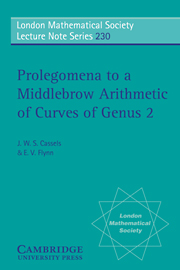Book contents
- Frontmatter
- Contents
- Foreword
- Background and conventions
- Chapter 1 Curves of genus 2
- Chapter 2 Construction of the jacobian
- Chapter 3 The Kummer surface
- Chapter 4 The dual of the Kummer
- Chapter 5 Weddle's surface
- Chapter 6 ℭ/2ℭ
- Chapter 7 The jacobian over local fields. Formal groups
- Chapter 8 Torsion
- Chapter 9 The isogeny. Theory
- Chapter 10 The isogeny. Applications
- Chapter 11 Computing the Mordell-Weil group
- Chapter 12 Heights
- Chapter 13 Rational points. Chabauty's Theorem
- Chapter 14 Reducible jacobians
- Chapter 15 The endomorphism ring
- Chapter 16 The desingularized Kummer
- Chapter 17 A neoclassical approach
- Chapter 18 Zukunftsmusik
- Appendix I MAPLE programs
- Appendix II Files available by anonymous ftp
- Bibliography
- Index rerum et personarum
Chapter 8 - Torsion
Published online by Cambridge University Press: 10 November 2010
- Frontmatter
- Contents
- Foreword
- Background and conventions
- Chapter 1 Curves of genus 2
- Chapter 2 Construction of the jacobian
- Chapter 3 The Kummer surface
- Chapter 4 The dual of the Kummer
- Chapter 5 Weddle's surface
- Chapter 6 ℭ/2ℭ
- Chapter 7 The jacobian over local fields. Formal groups
- Chapter 8 Torsion
- Chapter 9 The isogeny. Theory
- Chapter 10 The isogeny. Applications
- Chapter 11 Computing the Mordell-Weil group
- Chapter 12 Heights
- Chapter 13 Rational points. Chabauty's Theorem
- Chapter 14 Reducible jacobians
- Chapter 15 The endomorphism ring
- Chapter 16 The desingularized Kummer
- Chapter 17 A neoclassical approach
- Chapter 18 Zukunftsmusik
- Appendix I MAPLE programs
- Appendix II Files available by anonymous ftp
- Bibliography
- Index rerum et personarum
Summary
Introduction. We shall consider two computational problems relating to the torsion group of the jacobian. First, given a curve of genus 2 defined over ℚ, how does one try to find the rational torsion group on the jacobian? Second, given an integer N, how does one try to find a curve whose jacobian has a rational point of order N? Neither of these questions been adequately answered, but we give an idea of the general strategy. the first question, we shall give a method which works well in practice, there is a crude algorithm which should be amenable to improvement. of the recent work on the second question comes down to a bag of tricks for searching for large torsion orders; we shall give the one which has proved successful in finding most torsion orders up to 29 over ℚ. There is yet any method for bounding the possible torsion which can occur.
Computing the group law. Since the next few chapters are to be devoted largely to computational techniques, we shall first illustrate the mechanical details involved in computing the group law on divisors in more detail than the description in Chapter 1. Any reader who is familiar with addition of divisors modulo linear equivalence can safely skip this section. We shall not be requiring any of the structure of the jacobian as a variety here, but are only interested in the group structure.
- Type
- Chapter
- Information
- Publisher: Cambridge University PressPrint publication year: 1996

